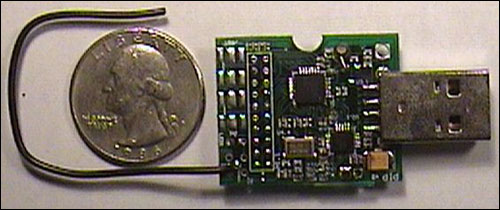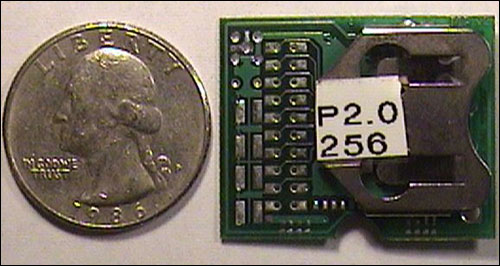Jun 18, 2010Two health-care companies and two U.S. Department of Defense (DOD) agencies are testing a prototype of a new active RFID system known as Roll-Call. The new system promises tags that are smaller and less expensive than active tags currently on the market, and that are designed to operate in hostile environments, such as those with densely packed, tagged products or a high quantity of metal. Developed by InPoint Systems, a start-up company based in Los Altos, Calif., the Roll-Call system can not only determine a tag's location, but also provide information regarding the tag's movement and any activity around it, says Eitan Fenson, one of the company's four founders.
Unlike most RFID transponders, whether passive or active, a Roll-Call tag transmits only its license plate (the payload) at a preprogrammed rate—every five seconds, for example—while it has no other built-in intelligence or "overhead," such as instructions allowing the tag to store information or receive transmission from readers. The tag, which Fenson describes as "brain dead," simply transmits a ultrahigh-frequency (UHF) 900 MHz signal encoded with an ID number, using a proprietary air-interface protocol. Because that is all the data being sent, it can operate in environments in which passive or other active tags may struggle, such as around large amounts of metal.
The intelligence, Fenson says, is built into the reader side of the system. A simple reader module, used merely to receive the tags' signals, plugs into a USB port of what InPoint calls a hub—a small, off-the-shelf Linux computer with Power over Ethernet (or any other generic computer running on a Linux operating system)—which is loaded with software that records and analyzes the tag signals. Two or more reader modules connected to a single hub via USB cables could cover a 400-square-foot space, such as a typical jewelry store. With multiple hubs, the data is then forwarded to a central server, where the Roll-Call software calculates a specific tag's location in 2-D using the Generalized Real-time Adaptable Indoor Localization (GRAIL) algorithms developed by Kordinate, a real-time locating system (RTLS) research-and-development firm based in Metuchen, N.J. During the past two years, Kordinate assisted InPoint in the research and development of the Roll-Call system, says Richard Martin, Kordinate's chief scientist and an associate professor at Rutgers University's computer science department. Some staff members and top executives of both companies serve on Rutgers' faculty.
With GRAIL, Martin explains, the system can not only determine a tag's approximate location within about 10 feet, but also determine when its RF signature changes, which would occur if the tag moved at all, or if something passed in front of it. This detection of movement, Fenson says, is of greater importance to many end users (including jewelry retailers) than location data more precise than 10 feet.
A server using data from an array of computers (hubs) fitted with Roll-Call RFID reader modules is able to discern whether a tag has moved, or if an untagged person or object has moved around it, based on a change in the RF signature. The readers can also capture the ID numbers of more than 1,000 tags per second, Fenson says, and they can successfully do this with tags from a distance of 20 feet to hundreds of feet, in densely packed, highly metallic environments with a great deal of background RF noise. A hub with a single reader module, he adds, can process beacons from several thousand tags continuously. "Our simulations yield results in excess of 10,000 tags in benign circumstances," he says, estimating a more challenging environment to be approximately 3,000. A single computer can serve as a hub for as many as four reader modules, thereby providing a measure of redundancy and resulting in even higher read rates.
Fenson and his colleagues initially developed the technology to track jewelry, and two of the founding members come from the jewelry retail industry. The challenge at that time, about two years ago, was to develop a system that would provide jewelry retailers with real-time data regarding the location of a large number of items from a tag small enough to be attached to each ring, necklace, bracelet or watch. As the jewelry industry has been in recession, Fenson says, the company is now targeting several other markets.
There are other systems that can achieve high read rates in challenging environments as well, such as Mojix's STAR system. In the Mojix system, one or more STAR receivers (readers) manage a network of eNode RF transmitters potentially covering an area of up to 250,000 square feet, and providing a tag read rate of up to 700 passive UHF EPC Gen 2 tags per second. The STAR system, Mojix claims, can read tags as far as 600 feet away, and identify their locations in 3-D to within a 1-foot radius (see Mojix Takes Passive UHF RFID to a New Level). Lufthansa, in fact, is using the STAR system to track pallets in a 50,000-square-foot warehouse at Frankfurt Airport (see Lufthansa Expands RFID Use).
Passive EPC Gen 2 RFID tags are available for less than 25 cents apiece—a fraction of the $30 that a Roll-Call tag would currently cost, assuming it were commercially available. The InPoint readers, however, offer similar results at a low cost, Fenson says. An interrogator consisting of a reader module connected to a single computer (if using the off-the-shelf Linux box that InPoint provides) is expected to cost a user about $350. "We anticipate that a 'starter' kit of 100 tags, 10 reader modules, three hubs and standard Roll-Call software will sell for less than $10,000," he states. "Additional tags and reader modules will sell for under $30 apiece in small volume, and additional hubs for less than $350, also at small volume."
Although EPC tags were initially designed to be encoded only with a unique ID number, they now are available with extra user memory for data storage, and can be queried by a reader, thereby transmitting the overhead that the InPoint system has eliminated. And because EPC tags are passive, Fenson notes, the read range is not usually as great as what the Roll-Call tags would offer, though Mojix claims its STAR system can read passive EPC tags from a distance of 600 feet.
A prototype of the tags and readers is currently being tested by two DOD agencies and two health-care facilities, all located in New Jersey, to evaluate the system's ability to track items in challenging environments.
"We are at the stage where we have the technology that we think is applicable across many industries," Fenson says. For example, the DOD's Communications-Electronics Research, Development, and Engineering Center (CERDEC), in Fort Monmouth, purchased a kit that included 10 Roll-Call tags, four reader modules and a single hub, as well as software to manage the readers and interpret the tag-read data. The agency utilized the kit to test the Roll-Call system's ability to track military inventory, such as equipment destined for Iraq, though Fenson declines to provide additional details of that testing.
InPoint has partnered with WinLab, at Rutgers University, to develop the system for the health-care industry as well, using it to tag medical records, equipment and patients. (InPoint's co-founder, Rich Howard, is one of WinLab's visiting professors.) When comparing Roll-Call with any other active RFID solution currently on the market, Fenson says, "the main advantage is [the] size and price" of InPoint's tags.

Both health-care companies testing the system have asked to remain unnamed. The function of identifying the movement of, or around, a tag can be useful in many industries, Fenson says—and in this case, it can be accomplished without motion sensors. In a hospital, for example, the system can determine the amount of activity there has been around a specific patient, even if those administering to that individual lack tags, thus indicating he or she is receiving some assistance.
The movement-detecting function can also provide security alerts in, for example, a retail application, identifying the presence of someone in a location, such as a storage room, at a time when people are not permitted (the individual would need to be between the tag and the reader, and within 20 feet of the tag). This is accomplished by detecting a change in the tag's RF signature, or by identifying how often a product is picked up and placed back on a store shelf. While the tags are still too large for tracking most individual items of jewelry , they can be used on cartons to track the location of goods within a supply chain, as well as to track work in progress on some jewelry.
The system also supports sensor data, though there have not been any pilots of a sensor used with the Roll-Call hardware. A tag with an integrated sensor would have a reduced battery life (according to InPoint, the battery of a tag without a sensor, beaconing every two seconds, is expected to last for up to five years), and could also suffer some reduction in reception by the reader due to the larger packet payload. However, Fenson adds, "Because sensor data does not typically require 100 percent reliable packet reception every second, that overall effect should be minimal."



